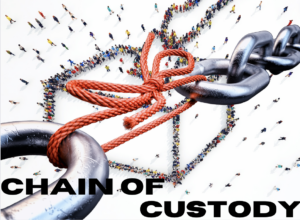
Fortifying the chain of custody: Shore up weak links in election security
We’ve all heard the cliché,
“we’re only as strong as our weakest link.”
Though there is truth to that saying, it doesn’t capture the gravity of a broken link in the administration of an election when it comes to chain of custody.
Picture this: some friends are gathered for a nice meal to celebrate a special occasion. They’ve been talking about it for months. The atmosphere, service, and comradery are A+. The magic moment arrives as the wait staff carries your meals through the kitchen doors. Then a waiter slips as they approach the table. The carefully prepared meal slides off the tray and lands all over your favorite outfit. You did nothing to cause this accident, but suddenly all eyes are on you.
Ever since the 2016 United States presidential election, states and localities have had all eyes on them. After the 2020 election, we were scrambling to understand chain of custody, implement strict procedures, and educate the public on those procedures to help calm the storm of narratives suggesting that voting machines had been tampered with or ballots had been improperly handled.
Chain of custody ─ what is it? The National Institute of Standards and Technology (NIST) defines “Chain of Custody” as:
“A process that tracks the movement of evidence through its collection, safeguarding, and analysis lifecycle by documenting each person who handled the evidence, the date/time it was collected or transferred, and the purpose for the transfer.”
The key word in this definition is “evidence.”
Chain of custody logs are the proof that every transfer of an asset is documented with no gaps in their whereabouts.
Having a strict chain of custody plan typically involves preselected personnel who will be picking up and dropping off each asset, collecting the date and time of the transfer, serial numbers, security locks & tamper evident seal numbers, and signatures of the transporter and recipient. Anytime additional evidence such as pictures and video can be incorporated, capturing the various data being entered in the log, the stronger your chain of custody log will be. The stronger your chain of custody log is, the more it will support the fact that your election was secure, accurate, and administered with integrity.
We discussed this in an earlier blog about election security, Part 2: Dismantle voter misperception brick by brick through election transparency. Having a solid record of your chain of custody for all the components of your voting systems, electronic and paper poll books, electronic media, and ballots (to include absentee returns) is a tool election administrators have within their control. Your voting equipment chain of custody demonstrates that the assets used in an election were secure and protected, thereby establishing evidence of election integrity that builds public trust.
When crafting a chain of custody policy, you can’t just plan for the perfect world scenario ─ you need to have a response plan in place for when things go sideways. What will you do if a handoff isn’t documented? How will you best ensure that the piece of equipment or ballot box wasn’t tampered with during the period not captured on your chain of custody log? Whenever there is a break in the chain, your response is critical.
As with any policy, your chain of custody policy needs to be continually reevaluated to see where you could introduce changes for greater efficiency and accuracy.
If you are an election administrator and have not instituted a chain of custody policy or plan, now is the time to get started. With the ongoing dissection of elections, and the public’s waning trust, not having a chain of custody policy is simply irresponsible. When election administrators take these critical steps to secure their elections, it overwhelmingly helps support the national narrative that the election process in place today can be trusted.
Going back to the restaurant story, what do you remember first? Is it the laughs with friends, or the cringey feeling that suddenly everyone is staring at you? And would you think twice about returning to a place that didn’t mitigate risks like a slippery floor? In the same way, voter trust in the election system is damaged when links in the chain of custody are broken.
Looking for chain of custody resources?
- The Importance of a Clear Chain of Custody in 2022 and Beyond;
- The Election Assistance Commission (EAC) has a Secure Elections Toolkit that contains very helpful information as it relates to chain of custody;
- NIST has standards for Physical and Environmental Security Controls that will help inform your policy; and
- The Cybersecurity & Infrastructure Security Agency (CISA) has a concise document on chain of custody that is well worth the read – Chain of Custody and Critical Infrastructure Systems.